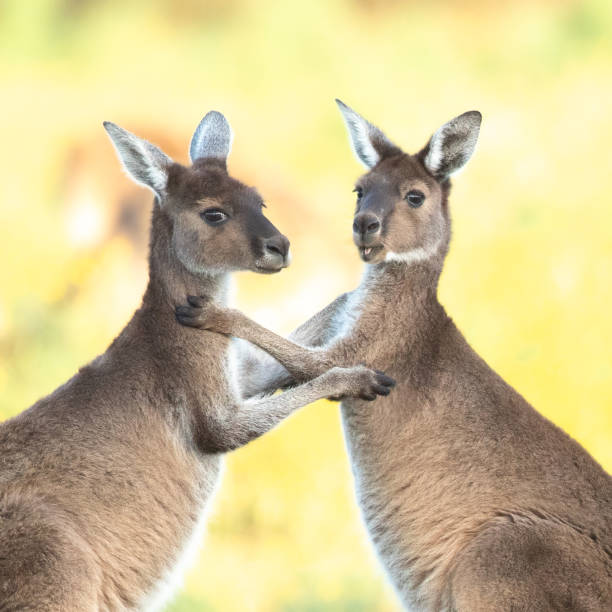ANIMAL: Western Gray/Grey Kangaroo Macropus fuliginosus Type of Animal: Macropod Habitat: Woodlands, forests, coastal heathland, grasslands, scrubland, scrub forest, golf courses, city/urban areas, agricultural areas, desert, xeric shrubland, plains, goldfields, bush, timber reserves, pastureland Location(s): Southern Australia Appearance: Grayish-brownish fur, paler throat/chest/belly, dark face (sometimes called Black-Faced Kangaroo), long thick tail, short forearms, small head, large ears, males larger/more muscular w/ heavier claws & thicker skin than females Food/Diet: Grasses, shrubs, leaves, forbs, tree bark, stems, wood, flowers, ferns, moss, insects, fruits, low trees, grass trees, lilies, chenopods, succulents, heath, lupin crops, poison bush, acacia seedlings Status in Wild: Stable Conservation: Breeding in farms, zoos & wildlife parks Lifestyle: Mobs consist of dominant male, 5-10 females & offspring, & often several subordinate males. Additional Info: Called: Male: Boomer Female: Flyer Young: Joey Group: Mob Weight: Male: 121.5 lbs Female: 63 lbs Young: 4-8 lbs Gestation: 1 month Life Span: 10 years in wild, 20 years in captivity Height: Male: 5.7-6 ft Female: 4 ft Body Length: Male: 3.1-5 ft Female: 2.2-3.3 ft Tail Length: Male: 1.39-3.28 ft Female: 1.43-2.67 ft Main predators are dingoes & dogs. Wedge-Tailed Eagles take females & joeys. Foxes only take joeys. Sexually mature at 17-20 months. Considered pests in some areas due to competition for water & pasture as well as feeding habits. Sometimes farmed/hunted for meat & leather. Males fight by boxing. Joeys born at around 0.8 grams, growing in pouch until 9-10 months of age & nursing for up to 6 more months-female can breed again when joey leaves pouch. Joey stays w/ mom for 1.3-2 years & sometimes longer, especially females. Tail used as balance in locomotion. They spend between 6-10 hours grazing, typically at dawn & dusk. Thicker belly skin on males helps absorb impact of kicks from rivals. They pant, sweat, & lick forearms to cool down. Fun Fact(s): In colonial times, they were hunted in similar way to English foxhunts. Microorganisms living in forestomach aid in digestion & detoxifying chemical plant defenses. They have excellent hearing & can swivel ears in any direction to pick up sounds. They communicate w/ each other through soft clicks. They can reach 35 mph in short bursts. Males sometimes called “stinkers” due to curry-like odor.
